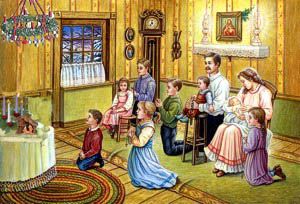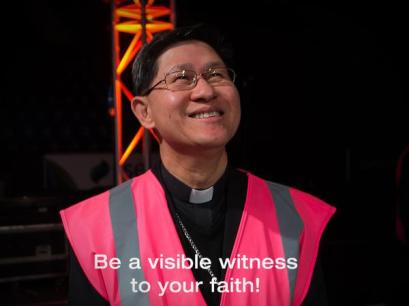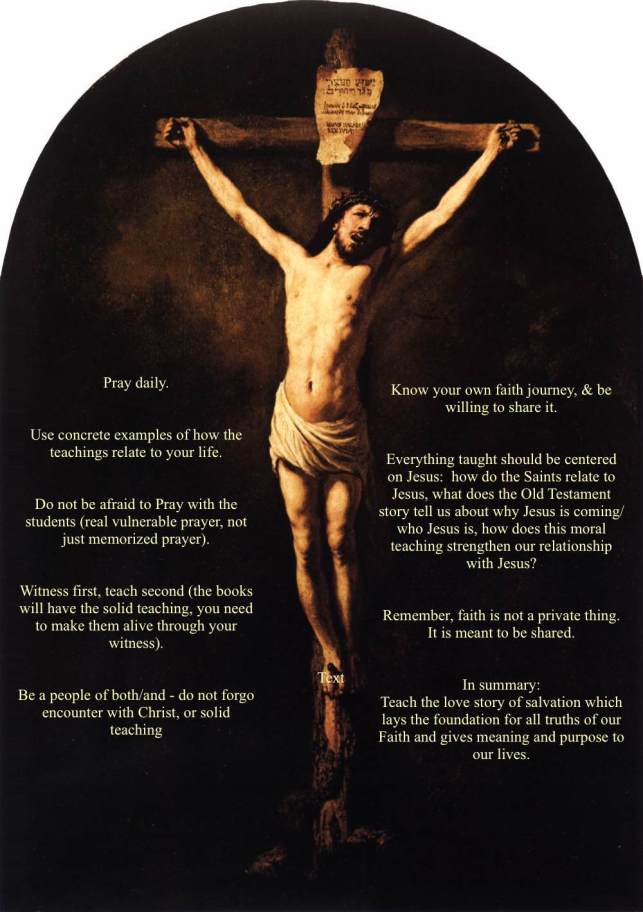By Jamin Herold, Associate Director – New Evangelization, Diocese of Kalamazoo
kerygma noun ke·ryg·ma \kə-ˈrig-mə\
: the apostolic proclamation of salvation through Jesus Christ
A longstanding debate in the field of Catechesis centers on the idea of solid theological content versus the idea of evangelistic welcoming in the classroom. Often, Americans working in this field have encamped themselves in the either/or of these two camps, reflecting the trend toward polarity in our culture.
In one way it makes sense we would do this. After all, for years the field of catechesis has been wrapped in the dogmatic memorization of the Baltimore Catechism, while the first inklings and basic proclamation of faith had already been fostered in the children at home. It was in the home where they first encountered Church through their families, at the dinner table, at nightly prayer, through the devotions. The lives of the faithful were truly integrated with the life of faith in their homes and with their friends.
As time passed, society changed: migration away from the Catholic ethnic neighborhoods, the shift away from Catholic Schools, and the deterioration of the family. These changes led to the evaporation of the first kindling of faith and the basic proclamation of the Gospel away from the setting of the family.
As this change occurred some believed that holding true to the tradition of the memorized texts of the Baltimore Catechism would be the saving grace. Others thought that a new method was needed; one that did not focus on the theological concepts of the Faith, but on minimizing the amount of teaching, and encouraging a focus on “Jesus loves you”. Many believed the stern, absolutism of the teachings of the Church were actually leading the flock away from faith.
Now, we have many who can recite the Baltimore Catechism, and yet have no idea what it means, or how to have relationship with Jesus through those texts. In fact, for many, hearing the words, “personal relationship with Jesus” sounds Protestant. We have a whole new generation of Catholics who still have no relationship with Jesus, but they know of some “idyllic person” named Jesus who loves them, and allows them to do whatever they want. They have encountered a false love, a false mercy, neither tempered with truth and justice.
Both camps have it right, but in having it right, they also have it wrong. The faith is never an “either/or” but a “both/and”. The theological truths of the Church will never mean anything without a true encounter with Jesus Christ. And, the love invitation has no validity without the knowledge of who Jesus Christ is within the fullness of the theological truths.
So where do we find ourselves today? What does this mean for your classrooms? How do we become a people of both/and? How can the Kerygma (the basic proclamation) change all that we do with our students?
Look to all the CARA, BARNA, Pew Research, and other similar studies. We are a post-Christian society, and more so every year. We are a Catholic Church that has either no encounter with the risen Christ, or no understanding of who this Christ is. What this means is that the catechist’s job has become that much more difficult.
Catechists are now, not only needing to convey the immense theological truths of the Church and who Jesus Christ is, they must also provide for the lack of the initial kindling of faith, that used to be formed in the family.
As Pope Paul VI in Evangelii Nuntiandi said, “modern man listens more willingly to witnesses than to teachers, and if he does listen to teachers, it is because they are first witnesses”.
How much more that is true now; most of the faithful and their children have never encountered witnesses of faith. This witness is not being passed on to future generations.
Understanding and encountering the Kerygma is the key solution to these issues. First, you must encounter this yourself. The basic proclamation that:
God created out of love,
We rejected that love,
Sin ruptured our relationship with God,
Sacrificial death of a pure victim was the only way to overcome that rupture,
God supplied Himself (Jesus Christ, the second person of the Trinity) as the sacrifice,
Jesus rose from the dead, He established the Church to supply the world with His grace, and The Holy Spirit is given to the Church and each of her members,
As Church we live as bride and bridegroom with Jesus Christ,
And we are called to repentance,
To a life of service to God and others,
To worship and prayer,
And to lives of obedience to God.
We must acknowledge that each one of us is broken and in need of a Savior,
Jesus Christ is that Savior,
He has come and healed each of us.
Once we have not just heard this basic proclamation, but also put it into effect in our lives, changed and repented of our old lives, and willing to live a new life in Christ, then and only then can we be witnesses.
This message must be entwined throughout the fabric of the strong theological teaching we have in the classroom. Nothing should be taught without looking through the lens of the Kerygma, pointing to and flowing from who Jesus Christ is, and how the Kerygma fits into the lives of the children.
The truths we teach in the classroom will now have meaning, purpose and an encounter with the living God. When the Kerygma is brought into the classroom we are no longer teaching theological statements to be memorized like multiplication tables, but we are introducing people to the Beloved. Now, when we speak of a God who loves, it is not just empty promises, or a mythological love that is promised, but rather an encounter with the Cross – where justice and mercy meet. That love is a person; all who encounter Him will thirst more and more, they will drink in the beauty of His Truth.
This is truly one of the most vital things we do as catechists, to proclaim the basic Gospel truths, through our own encounter, and to expand on this message with all we teach.
So, how do we integrate the Kerygma into each lesson we teach? Here are some ideas:






Please feel free to comment on this article. We want folks to share their thoughts and experiences!
LikeLike
As a catechist, I keep trying to impress upon my 10th graders that Jesus is truly present in the Blessed Sacrament. The precepts of the church makes sense only when that unimaginably wonderful truth is accepted.
LikeLike
Happy All Saints Day! I know it has been a month since this article came out but it’s very relevant to me and I just found it. I’m a new teacher at a Catholic inner-city school where the majority of the students are not Catholic and/or don’t go to any church. I’m having a hard time doing both, the curriculum and sharing my faith journey. I’ve been a catechist in faith formation (volunteer) and now having to grade a religion class is difficult. Are there any suggestions that have worked in a Catholic school where the majority of students are not practicing Catholic?
LikeLike